| Columns Retired Columns & Blogs |
Pass Labs INT-150 integrated amplifier Measurements
Sidebar 3: Measurements
To perform the measurements on the Pass Labs INT-150, I used Stereophile's loan sample of the top-of-the-line Audio Precision SYS2722 system (see the January 2008 "As We See It" and www.ap.com). Before doing the testing, I ran the INT-150 at one-third its rated power for 60 minutes, which thermally is the worst case for an amplifier with a class-A/B output stage. At the end of that period, the heatsinks along the chassis sides were way too hot to touch. This amplifier needs plenty of ventilation.
The maximum gain at 1kHz was basically to specification, at 26.4dB into 8 ohms for both balanced and unbalanced inputs. These inputs were noninverting, assessed at both the loudspeaker jacks and the preamplifier outputs, and the XLR jacks appear to be wired with pin 2 hot. The single-ended input impedance was, at 42k ohms, twice the specified figure at low and midrange frequencies, dropping slightly to 33k ohms at the top of the audioband. The balanced input impedance was twice these values, as expected. The balanced preamplifier outputs offered a source impedance of 129 ohms over most of the audioband, rising to 426 ohms at 20Hz. There was a slight (0.72dB) insertion loss from these outputs, ie, a 1V input resulted in an output at the preamp jacks of 920mV.
The INT-150's output impedance at the speaker terminals was a fairly low 0.12 ohm in the bass and midrange, rising slightly to 0.16 ohm at 20kHz. As a result, the frequency-response modification due to the interaction between this impedance and the way a speaker's impedance varies with frequency was mild, at ±0.1dB (fig.1, gray trace). The Pass's output is flat almost down to the 10Hz LF limit of this graph; at the other end of the spectrum the response is –0.1dB at 20kHz and –3dB at 125kHz. This wide bandwidth results in an excellent 10kHz square waveform, with short risetimes but no overshoot or ringing (fig.2). These graphs were taken with the volume control at its maximum setting, "63"; commendably, reducing the setting to an indicated "40" didn't change the amplifier's bandwidth. The volume control operated in accurate 1dB steps. The front-panel volume control, which is actually a rotary shaft encoder, worked perfectly throughout my testing, so I am not sure why it failed during EL's auditioning.
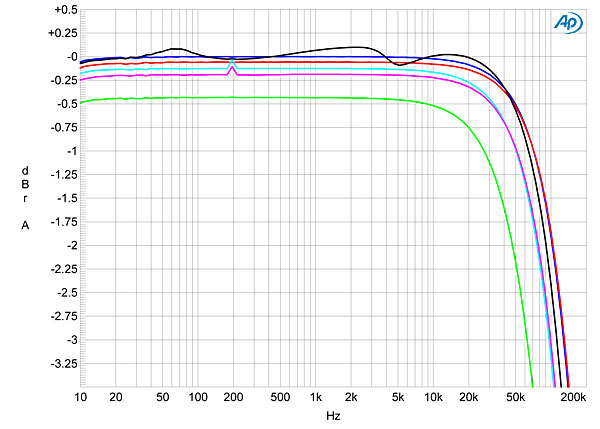
Fig.1 Pass Labs INT-150, frequency response at 2.83V into: simulated loudspeaker load (gray), 8 ohms (left channel blue, right red), 4 ohms (left cyan, right magenta), 2 ohms (green). (1dB/vertical div.)
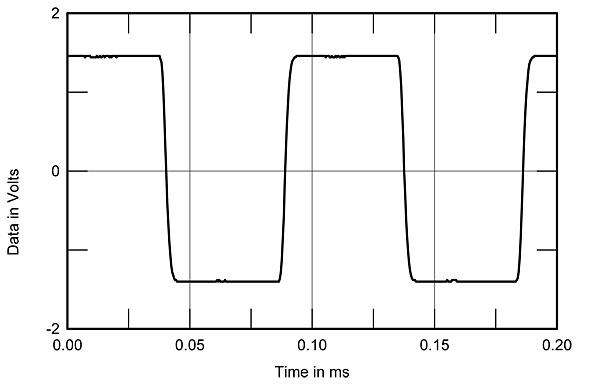
Fig.2 Pass Labs INT-150, small-signal 10kHz squarewave into 8 ohms.
Channel separation was excellent, at >100dB in both directions below 2kHz, and still 90dB at 20kHz. The INT-150 was also very quiet. With the volume control at "63" but the input shorted, the wideband signal/noise ratio was 79.8dB in the left channel and 76.3dB in the right, ref. 1W into 8 ohms. Switching in an A-weighting filter increased these figures to 85 and 80dB, respectively.
Specified as delivering 150Wpc into 8 ohms at 1% THD (21.8dBW), the INT-150 proved more powerful than that on my test bench, giving 191W into 8 ohms (22.8dBW) at this distortion level with both channels driven (fig.3, bottom trace). It output 284Wpc into 4 ohms (21.5dBW), but only 225W into 2 ohms (17.5dBW) with one channel driven. With both channels driven into 2 ohms, the rear-panel 4A fuse blew after just 15 seconds of continuous running at powers greater than 100W.
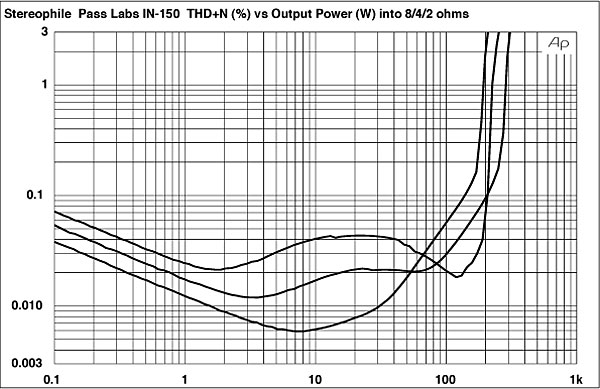
Fig.3 Pass Labs INT-150, distortion (%) vs 1kHz continuous output power into (from bottom to top at 10W): 8, 4, 2 ohms.
The shape of the traces in fig.3 reveals that the THD+noise percentage is dominated by noise below 8W or so. I therefore measured how the distortion changed with frequency at a level of 10V, equivalent to 12.5W into 8 ohms (fig.4, blue and red traces), 25W into 4 ohms (cyan, magenta), and 50W into 2 ohms (green). The right channel is not quite as linear as the left, but the INT-150 still offers uniformly low distortion below 1kHz into all loads. The THD rises in the top octaves, due to the usual reduction in open-loop gain margin at high frequencies, and the amplifier is starting to be stressed a little above 10kHz into 2 ohms.
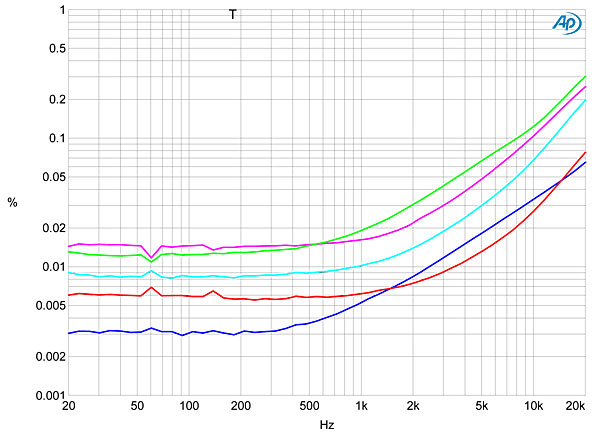
Fig.4 Pass Labs INT-150, THD+N (%) vs frequency at 10V into: 8 ohms (left channel blue, right red), 4 ohms (left cyan, right magenta), 2 ohms (green).
Into 8 ohms at moderate powers, the distortion is primarily the subjectively innocuous third harmonic (fig.5), but higher-order harmonics appear at higher powers and into lower impedances (fig.6). The third harmonic remains the highest in level, but at even higher powers, some odd-order harmonics of the AC power supply can be seen (fig.7). I experimented with the grounding between the amplifier and the test system, including floating the AC cord and running a separate connection from the system's chassis ground to the grounding post on the amplifier's rear panel, but there was no significant change in this behavior.
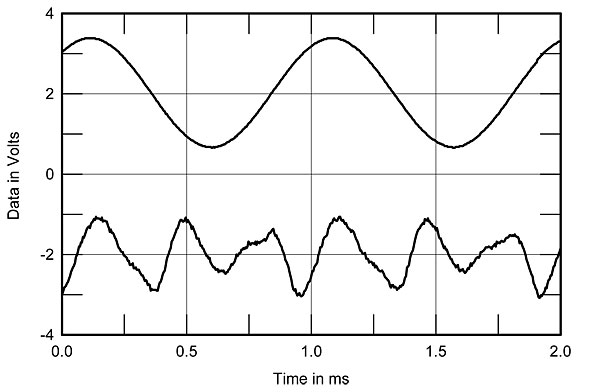
Fig.5 Pass Labs INT-150, 1kHz waveform at 14W into 8 ohms (top), 0.0049% THD+N; distortion and noise waveform with fundamental notched out (bottom, not to scale).
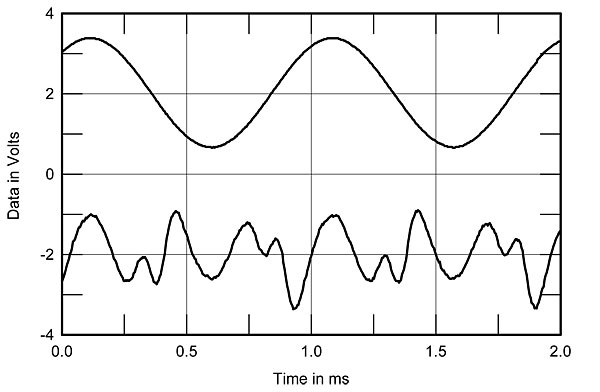
Fig.6 Pass Labs INT-150, 1kHz waveform at 27W into 4 ohms (top), 0.0099% THD+N; distortion and noise waveform with fundamental notched out (bottom, not to scale).
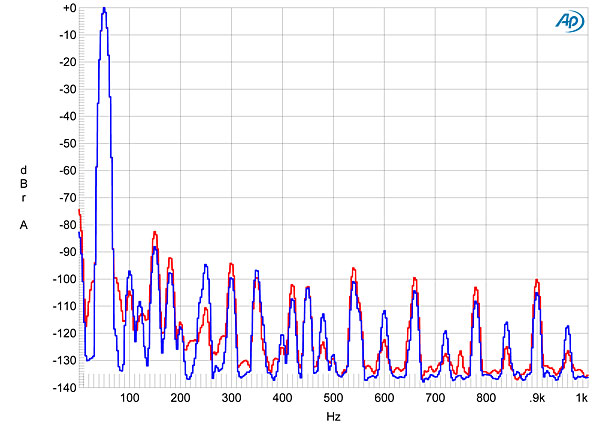
Fig.7 Pass Labs INT-150, spectrum of 50Hz sinewave, DC–10kHz, at 55Wpc into 4 ohms (left channel blue, right red; linear frequency scale).
The circuit's less-good linearity at high frequencies doesn't result in any significant second-order intermodulation product with the demanding high-power mix of 19kHz and 20kHz tones, the 1kHz difference component lying at almost –100dB (0.001%). However, the higher-order products at 18 and 21kHz are almost 40dB higher in level (fig.8).
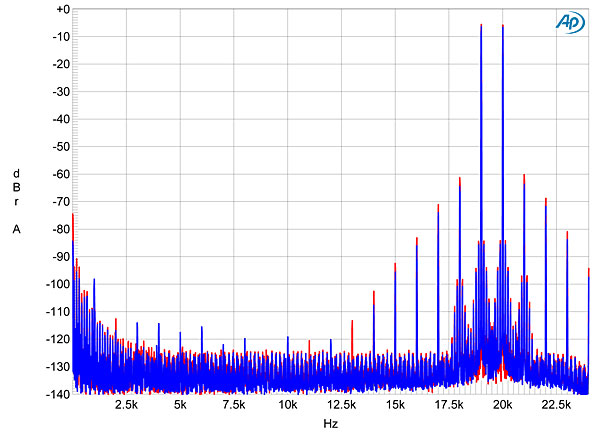
Fig.8 Pass Labs INT-150, HF intermodulation spectrum, DC–24kHz, 19+20kHz at 100W peak into 8 ohms (linear frequency scale).
As I have come to expect from a Nelson Pass design, the INT-150 offers excellent measured performance in most respects.—John Atkinson
- Log in or register to post comments




































